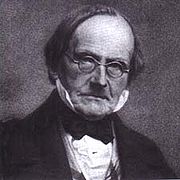
Jean de Charpentier
Encyclopedia

Geologist
A geologist is a scientist who studies the solid and liquid matter that constitutes the Earth as well as the processes and history that has shaped it. Geologists usually engage in studying geology. Geologists, studying more of an applied science than a theoretical one, must approach Geology using...
who studied Swiss glacier
Glacier
A glacier is a large persistent body of ice that forms where the accumulation of snow exceeds its ablation over many years, often centuries. At least 0.1 km² in area and 50 m thick, but often much larger, a glacier slowly deforms and flows due to stresses induced by its weight...
s. He was born in Freiberg
Freiberg, Saxony
Freiberg is a city in the Free State of Saxony, Germany, administrative center of the Mittelsachsen district.-History:The city was founded in 1186, and has been a center of the mining industry in the Ore Mountains for centuries...
, Saxony
Saxony
The Free State of Saxony is a landlocked state of Germany, contingent with Brandenburg, Saxony Anhalt, Thuringia, Bavaria, the Czech Republic and Poland. It is the tenth-largest German state in area, with of Germany's sixteen states....
, Germany
Germany
Germany , officially the Federal Republic of Germany , is a federal parliamentary republic in Europe. The country consists of 16 states while the capital and largest city is Berlin. Germany covers an area of 357,021 km2 and has a largely temperate seasonal climate...
and died in Bex
Bex
Bex is a municipality in the canton of Vaud, Switzerland, located in the district of Aigle. It is a few miles south of its sister town municipality of Aigle.-The Bex Salt Mine:Bex is the site of a famous salt mine....
, Switzerland
Switzerland
Switzerland name of one of the Swiss cantons. ; ; ; or ), in its full name the Swiss Confederation , is a federal republic consisting of 26 cantons, with Bern as the seat of the federal authorities. The country is situated in Western Europe,Or Central Europe depending on the definition....
.
After following in his father's footsteps as a mining engineer he excelled in his field while working in the copper mines in the Pyrénées and salt mines in western Switzerland.
In 1818 a catastrophic event changed his life focus when an ice-dammed lake in the Val de Bagnes above Martigny broke through its barrier, causing many deaths. Afterwards, he made extensive field studies in the Alps. Using evidence of erratic boulders and moraines and drawing on the works of Goethe, he hypothesized that Swiss glaciers had once been much more extensive. These boulders, characteristic of glaciers, were strewn as if they were brought there by glaciers
Glacial erratic
A glacial erratic is a piece of rock that differs from the size and type of rock native to the area in which it rests. "Erratics" take their name from the Latin word errare, and are carried by glacial ice, often over distances of hundreds of kilometres...
that no longer existed, in contrast to the previous idea that the Biblical Flood had causing this deposition. Even so, he wasn't sure how glaciers first formed, moved, or how they disappeared. His ideas were later taken up and developed by Louis Agassiz
Louis Agassiz
Jean Louis Rodolphe Agassiz was a Swiss paleontologist, glaciologist, geologist and a prominent innovator in the study of the Earth's natural history. He grew up in Switzerland and became a professor of natural history at University of Neuchâtel...
.
See also: ice age
Ice age
An ice age or, more precisely, glacial age, is a generic geological period of long-term reduction in the temperature of the Earth's surface and atmosphere, resulting in the presence or expansion of continental ice sheets, polar ice sheets and alpine glaciers...

